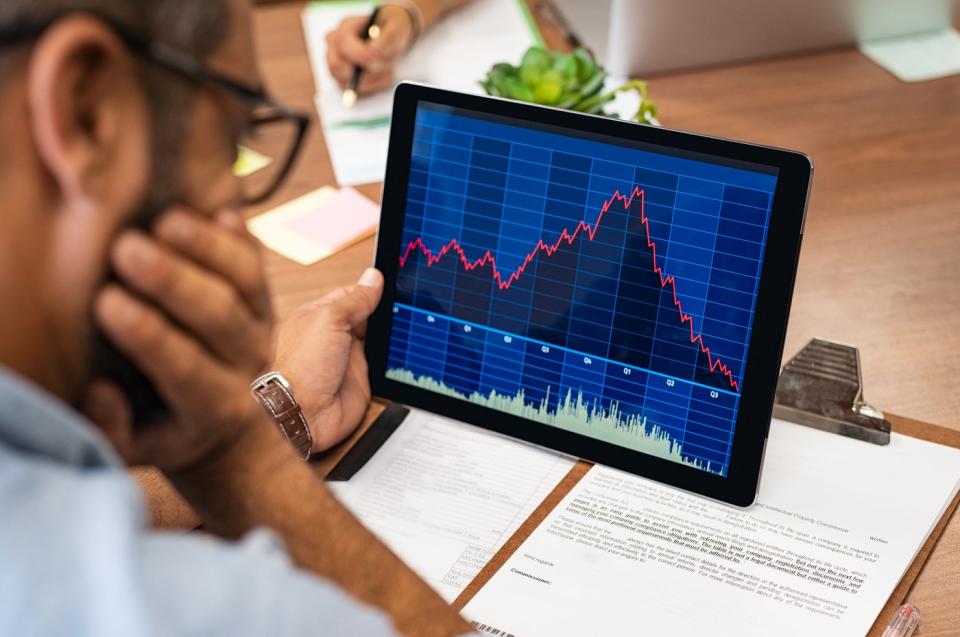Stocks Have Been This Pricey Only 3 Times in 153 Years -- and You're Not Going to Like What's Happened Following the Prior 2 Instances
Over the last century, stocks have been on a pedestal of their own. Although other asset classes, including Treasury bonds, gold, oil, and housing, have produced positive nominal returns, nothing else has come close to generating the annualized total return that stocks have delivered.
Despite this outperformance, stocks don't move higher in a straight line. From point A to point B, the journey resembles a winding road filled with various potholes and speed bumps.
Even though the ageless Dow Jones Industrial Average (DJINDICES: ^DJI), benchmark S&P 500 (SNPINDEX: ^GSPC), and growth-focused Nasdaq Composite (NASDAQINDEX: ^IXIC) are all firmly in a bull market and just a stone's throw from respective all-time highs, one valuation tool suggests the party is set to come to an abrupt end.

Stocks are historically pricey, and that spells trouble for Wall Street
For more than a year, I've been examining no shortage of market events, data points, and valuation metrics that have, throughout history, strongly correlated with moves higher or lower in the broader market. Examples include the first meaningful decline in U.S. M2 money supply since the Great Depression, the longest yield-curve inversion on record, and the broader market's performance following the start of a rate-easing cycle.
However, the one tool that spells big-time trouble for Wall Street is the S&P 500's Shiller price-to-earnings (P/E) ratio. You'll sometimes see the Shiller P/E referred to as the cyclically adjusted price-to-earnings ratio, or CAPE ratio.
There's probably no valuation metric that investors are more familiar with than the traditional P/E ratio, which divides a company's share price into its earnings per share (EPS) over the trailing-12-month period. Meanwhile, the Shiller P/E takes into account average inflation-adjusted EPS over the last decade. Factoring in 10 years' worth of EPS history ensures that short-term shocks, such as COVID-19 lockdowns, don't adversely impact valuation models.
When the closing bell tolled on Sept. 5, the S&P 500's Shiller P/E was at 35.38, which works out to more than double the 17.16 average since January 1871. As you'll note from the chart above, the Shiller P/E has spent much of the last 30 years above 20, which is likely a function of the internet democratizing access to information and interest rates hovering below historic norms.
The scary thing for Wall Street and investors is that in 153 years, stocks have, collectively, been pricier on only two separate occasions from the present. During the dot-com boom, the Shiller P/E peaked at its all-time high of 44.19. Meanwhile, during the first week of January 2022, the Shiller P/E briefly topped 40.
In the years following the dot-com peak, the broad-based S&P 500 went on to lose 49% of its value, while the innovation-driven Nasdaq Composite shed 78% of its value on a peak-to-trough basis. The other instance of the Shiller P/E reaching 40 in January 2022 was followed by a bear market for the Dow Jones, S&P 500, and Nasdaq Composite.
Since 1871, there have been six occasions when the S&P 500's Shiller P/E has topped and sustained 30 during a bull market rally, including the current instance. All five prior occurrences resulted in the Dow, S&P 500, and/or Nasdaq Composite shedding between 20% and 89% of their value.
Although the Shiller P/E isn't a timing tool — valuations can remain extended for weeks, months, or even years — it's foreshadowed a big drop in equities, without fail, when back-tested more than a century. With stocks at their third-highest valuation in history, there's a strong likelihood of a sizable pullback in the months/years to come.

Perspective is one of the most powerful tools investors possess
While the forecast of a big-time decline in the Dow Jones Industrial Average, S&P 500, and Nasdaq Composite probably won't sit well with most investors, the silver lining is that time is very much on the investor's side, and perspective changes everything.
As an example, a number of predictive indicators are pointing to economic weakness in the not-too-distant future. A lengthy inversion of the yield curve between 10-year Treasury bonds and three-month Treasury bills has signaled one of the highest probabilities for a U.S. recession that we've seen since the early 1980s.
As much as working Americans and investors might dislike recessions, they're a normal and inevitable part of the economic cycle. Most importantly, they have a history of resolving quickly. Of the 12 U.S. recessions since the end of World War II, nine were completed in under a year, while the remaining three failed to surpass 18 months in length.
On the other side of the coin, two economic expansions have surpassed the decade mark since September 1945, with most periods of growth enduring for multiple years. The economic cycle isn't linear and undeniably favors those with the foresight to wager on long-term expansion.
What's noteworthy is that we see this same non-linearity in the stock market.
It's official. A new bull market is confirmed.
The S&P 500 is now up 20% from its 10/12/22 closing low. The prior bear market saw the index fall 25.4% over 282 days.
Read more at https://t.co/H4p1RcpfIn. pic.twitter.com/tnRz1wdonp-- Bespoke (@bespokeinvest) June 8, 2023
In June 2023, shortly after the S&P 500 was confirmed to be in a new bull market following its 20% rebound from its 2022 bear market lows, the researchers at Bespoke Investment Group published the data set you see above on X (the social media platform formerly known as Twitter). This data set detailed the length of every bull and bear market in the S&P 500 since the Great Depression began in September 1929.
The 27 S&P 500 bear markets over 94 years have lasted an average of 286 calendar days, which works out to about 9.5 months. On the other hand, the 27 bull markets since the Great Depression have endured an average of 1,011 calendar days, approximately 3.5 times as long. You might also notice that nearly half (13 out of 27) of the S&P 500 bull markets were longer than the lengthiest bear market.
Even without being able to pinpoint when stock market corrections will begin, how long they'll last, or how steep the peak-to-trough decline will be, investors' ability to take a step back, widen their lens, and examine the big picture puts time and history in their corner. Regardless of the stock market decline that may await, based on what the Shiller P/E ratio suggests, long-term-minded investors are well positioned for success.
Where to invest $1,000 right now
When our analyst team has a stock tip, it can pay to listen. After all, Stock Advisor’s total average return is 702% — a market-crushing outperformance compared to 161% for the S&P 500.*
They just revealed what they believe are the 10 best stocks for investors to buy right now…
*Stock Advisor returns as of September 3, 2024
Sean Williams has no position in any of the stocks mentioned. The Motley Fool has no position in any of the stocks mentioned. The Motley Fool has a disclosure policy.
Stocks Have Been This Pricey Only 3 Times in 153 Years -- and You're Not Going to Like What's Happened Following the Prior 2 Instances was originally published by The Motley Fool

 Yahoo Finance
Yahoo Finance